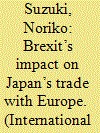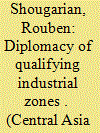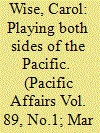|
|
|
Sort Order |
|
|
|
Items / Page
|
|
|
|
|
|
|
| Srl | Item |
| 1 |
ID:
178031


|
|
|
|
|
| Summary/Abstract |
In the context of globalization, the Japanese government emphasizes the importance of reinforcing the free trade system. Due to European Union’s (EU) reluctance, the free trade agreement (FTA) negotiations between Japan and the EU took 4 years to conclude. However, Brexit prompted the conclusion of Economic Partnership Agreement (EPA) with the EU as to maintain the economic interests of both sides after the British exit from the EU. The UK wants to maintain economic relations with Japan and to become a ‘Global Britain’ in the post-Brexit era. This article analyses both Japan–EU and Japan–UK FTAs. The core of the article looks at the impact of Brexit on Japan’s access to the European single market through a review of Japanese sectors and large corporations, particularly the automobile industry.
|
|
|
|
|
|
|
|
|
|
|
|
|
|
|
|
| 2 |
ID:
116618


|
|
|
|
|
| Publication |
2012.
|
| Summary/Abstract |
The Trans-Pacific Partnership (TPP) is a multilateral free trade agreement (FTA) which aims to liberalize the economies of the Asia-Pacific region. The rapid movement of the TPP agenda, however, has caused China some disquiet. Originally, the agreement was signed among four countries (Brunei, Chile, New Zealand and Singapore) on June 3, 2005, and entered into force on May 28, 2006. In 2008, five additional countries (Australia, Malaysia, Peru, the United States, and Vietnam) began negotiations to join the group.1 On November 12, 2011, the leaders of these nine TPP partner countries announced the broad outlines of an expanded TPP: it will promote innovation, enhance economic growth and development, and support the creation and retention of jobs among the nine dynamic Asia-Pacific economies.2 Further negotiations are still underway, with Japan, Canada, and Mexico also having demonstrated a strong interest in joining.
|
|
|
|
|
|
|
|
|
|
|
|
|
|
|
|
| 3 |
ID:
143215


|
|
|
|
|
| Summary/Abstract |
The author investigates an alternative, indirect settlement between Armenia and Turkey expected to lead the negotiations out of the dead end into which they were pushed by the refusal of Ankara and Yerevan to ratify the Zürich Protocols. On the one hand, American-Swiss mediation and the shuttle diplomacy of 2008-2009, crowned by the sensational signing of the Turkish-Armenian protocols, inflated international expectations. On the other, the euphoria created by what looked like a fundamental solution to one of the most complicated conflicts of the twentieth century proved to be short-lived.
|
|
|
|
|
|
|
|
|
|
|
|
|
|
|
|
| 4 |
ID:
143537


|
|
|
|
|
| Summary/Abstract |
One of the most prominent trends in Latin America in the 2000s has been the proliferation of bilateral free trade agreements (FTAs) across the Pacific basin. Beginning with the path-breaking Chile-Korea FTA in 2004 up to the Costa Rica-Singapore FTA in 2013, the past decade has seen the negotiation of twenty-two cross-Pacific accords. China, too, has jumped on to the cross-Pacific FTA bandwagon, including its negotiation of separate bilateral FTAs with Chile (2006), Peru (2009), and Costa Rica (2011). This paper analyzes the origins, content, and preliminary outcomes of these three China-Latin America FTAs. The findings are threefold: 1) in contrast with other cross-Pacific FTAs, which include at least one developed country, the three FTAs analyzed in this paper constitute “south-south” FTAs; yet, in contrast with other south-south FTAs, these three China-Latin America accords approximate WTO+ standards vis-à-vis the World Trade Organization (WTO) and its new trade agenda (services, investment, and intellectual property rights); 2) although the motives for negotiating these developing- developing country accords varied, on the part of China and the countries themselves, this did not disrupt the march toward WTO+ status; and 3) while all three of these FTAs elude standard theoretical explanations for the negotiation of bilateral FTAs, the three Latin American countries do share similar reform trajectories and institutional affinities, which sheds light on the decision and capacity of each to negotiate a bilateral FTA with China.
|
|
|
|
|
|
|
|
|
|
|
|
|
|
|
|
| 5 |
ID:
057636


|
|
|
|
|
|
|
|